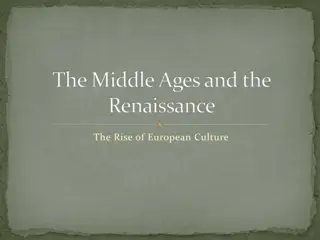
Proof of Middle Levels Conjecture in Graph Theory
Explore the fascinating problem of Hamilton cycles in graphs, particularly focusing on the middle layer graph and its intriguing properties. Delve into the question of whether the middle layer of a specific graph has a Hamilton cycle for every case, along with discussions on bipartite nature, connectivity, degrees, and automorphisms. Discover the complexity and challenges associated with determining the existence of Hamilton cycles in various graph structures.
Download Presentation

Please find below an Image/Link to download the presentation.
The content on the website is provided AS IS for your information and personal use only. It may not be sold, licensed, or shared on other websites without obtaining consent from the author. If you encounter any issues during the download, it is possible that the publisher has removed the file from their server.
You are allowed to download the files provided on this website for personal or commercial use, subject to the condition that they are used lawfully. All files are the property of their respective owners.
The content on the website is provided AS IS for your information and personal use only. It may not be sold, licensed, or shared on other websites without obtaining consent from the author.
E N D
Presentation Transcript
Proof of the middle levels conjecture Torsten M tze
Hamilton cycles Hamilton cycle = cycle that visits every vertex exactly once
Hamilton cycles Problem: Given a graph, does it have a Hamilton cycle? fundamental problem with many applications (special case of travelling salesman problem) computational point of view: no efficient algorithm known (NP-complete [Karp 72]), i.e. brute-force approach essentially best possible what about particular families of graphs?
The middle layer graph Consider the cube 11...1 111 level 3 level 2 110 101 011 level 1 100 010 001 level 0 000 00...0 Middle layer graph
The middle layer graph Consider the cube 11...1 111 level 3 level 2 110 101 011 level 1 100 010 001 level 0 000 00...0 Middle layer graph
The middle layer graph Middle layer of 10110 10101 01101 01011 00111 11100 11010 11001 10011 01110 10001 01100 00110 00101 00011 11000 10100 10010 01010 01001 Question: Does the middle layer of have a Hamilton cycle for every ?
The middle layer graph Middle layer of 10110 10101 01101 01011 00111 11100 11010 11001 10011 01110 10001 01100 00110 00101 00011 11000 10100 10010 01010 01001 bipartite, connected number of vertices: degree:
The middle layer graph Middle layer of 10110 10101 01101 01011 00111 11100 11010 11001 10011 01110 10001 01100 00110 00101 00011 11000 10100 10010 01010 01001 bipartite, connected number of vertices: degree: automorphisms: bit permutation + inversion,
The middle layer graph Middle layer of 10110 10101 01101 01011 00111 11100 11010 11001 10011 01110 10001 01100 00110 00101 00011 11000 10100 10010 01010 01001 bipartite, connected number of vertices: degree: automorphisms: bit permutation + inversion,
The middle layer graph Middle layer of 10110 10101 01101 01011 00111 11100 11010 11001 10011 01110 10001 01100 00110 00101 00011 11000 10100 10010 01010 01001 bipartite, connected number of vertices: degree: automorphisms: bit permutation + inversion, vertex-transitive
The middle levels conjecture Conjecture: The middle layer graph has a Hamilton cycle for every . also known as revolving door conjecture
The middle levels conjecture Conjecture: The middle layer graph has a Hamilton cycle for every . probably first mentioned in [Havel 83], [Buck, Wiedemann 84] also (mis)attributed to Dejter, Erd s, Trotter [Kierstead, Trotter 88] and various others exercise (!!!) in [Knuth 05]
The middle levels conjecture Conjecture: The middle layer graph has a Hamilton cycle for every . Motivation: Gray codes (applications e.g. in digital communication) 111 111 000 010 110 111 011 001 101 100 001 011 010 110 100 101 101 011 110 101 011 110 001 100 010 001 100 010 000 000
The middle levels conjecture Conjecture: The middle layer graph has a Hamilton cycle for every . Motivation: Conjecture [Lov sz 70]: Every connected vertex-transitive graph has a Hamilton cycle (apart from five exceptions).
History of the conjecture Numerical evidence: The conjecture holds for all [Moews, Reid 99], [Shields, Savage 99], [Shields, Shields, Savage 09], [Shimada, Amano 11]
History of the conjecture Asymptotic results: The middle layer graph has a cycle of length [Savage 93] [Felsner, Trotter 95] [Savage, Winkler 95] [Johnson 04]
History of the conjecture Other relaxations and partial results: [Kierstead, Trotter 88] [Duffus, Sands, Woodrow 88] [Dejter, Cordova, Quintana 88] [Duffus, Kierstead, Snevily 94] [Hurlbert 94] [Hor k, Kaiser, Rosenfeld, Ryj cek 05] [Gregor, krekovski 10]
Our results Theorem 1: The middle layer graph has a Hamilton cycle for every . Theorem 2: The middle layer graph has different Hamilton cycles. Remarks: number of automorphisms is only so Theorem 2 is not an immediate consequence of Theorem 1 ,
Our results Theorem 1: The middle layer graph has a Hamilton cycle for every . Theorem 2: The middle layer graph has different Hamilton cycles. Remarks: number of Hamilton cycles is at most so Theorem 2 is best possible ,
Our results Theorem 1: The middle layer graph has a Hamilton cycle for every . Theorem 2: The middle layer graph has different Hamilton cycles. Remarks: proof is constructive algorithm to compute the cycle (inefficient) [M., Nummenpalo 15+]: algorithm to compute next cycle vertex in time on average
Proof ideas Step 1: Build a 2-factor in the middle layer graph Step 2: Connect the cycles in the 2-factor to a single cycle
Structure of the middle layer graph A Hamilton cycle Catalan numbers
Structure of the middle layer graph A Hamilton cycle
Structure of the middle layer graph A Hamilton cycle
Structure of the middle layer graph A Hamilton cycle
Structure of the middle layer graph A Hamilton cycle
Step 1: Build a 2-factor Construction from [M., Weber 12] isomorphism (bit permutation + inversion) ???
Step 1: Build a 2-factor Construction from [M., Weber 12] 2-factor isomorphism (bit permutation + inversion)
Step 1: Build a 2-factor Construction from [M., Weber 12] parametrizing essentially only one can be analyzed: yields different 2-factors = plane trees with edges 2-factor Fundamental problem: varying changes globally
Step 2: Connect the cycles New ingredient: Flippable pairs is a flippable pair, if there is a flipped pair such that 2-factor
Step 2: Connect the cycles New ingredient: Flippable pairs is a flippable pair, if there is a flipped pair such that 2-factor
Step 2: Connect the cycles New ingredient: Flippable pairs 2-factor flippable pairs yield different 2-factors + very precise local control we can construct many flippable pairs
Step 2: Connect the cycles New ingredient: Flippable pairs 2-factor Auxiliary graph
Step 2: Connect the cycles Lemma 1: If graph contains a Hamilton cycle. is connected, then the middle layer Lemma 2: If the middle layer graph contains contains different spanning trees, then different Hamilton cycles. 2-factor Auxiliary graph
The crucial reduction Prove that Prove that middle layer graph has a Hamilton cycle (many Hamilton cycles) is connected (has many spanning trees)
Analysis of 2 leaves 6 leaves 5 leaves 4 leaves 3 leaves = plane trees with edges
Analysis of 2 leaves 6 leaves 5 leaves 4 leaves 3 leaves = plane trees with edges

![READ⚡[PDF]✔ Emerging Space Powers: The New Space Programs of Asia, the Middle Ea](/thumb/21554/read-pdf-emerging-space-powers-the-new-space-programs-of-asia-the-middle-ea.jpg)




















